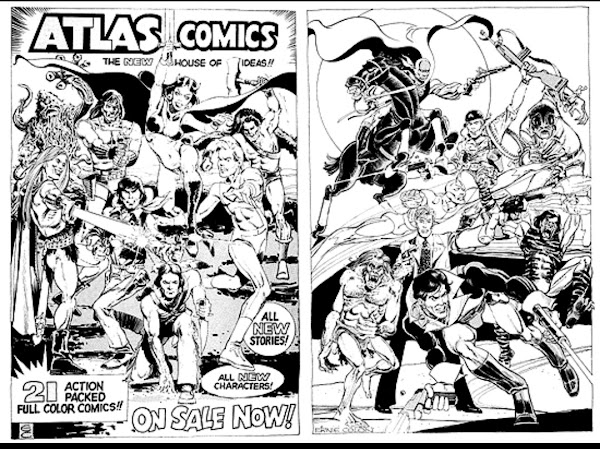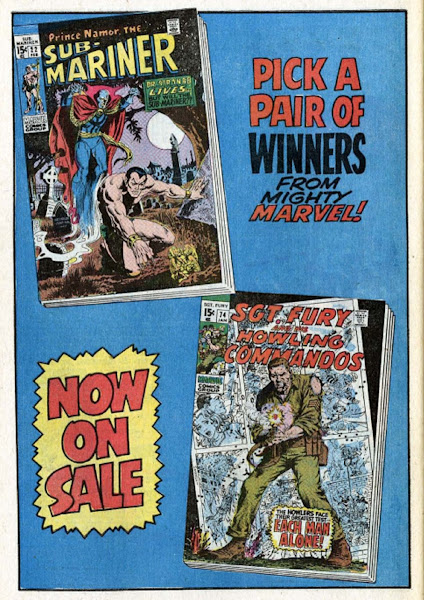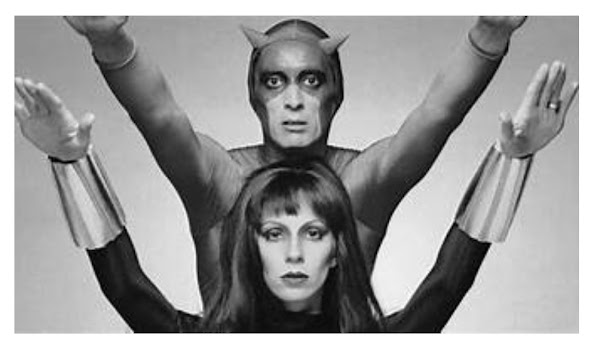Search This Blog
Thursday, January 27, 2022
House ads: Part three - The other companies
In parts 1 & 2 I showed some of my favourite DC and Marvel house ads. However, it wasn't just the big two that generated a mountain of great looking adverts there were many other comic book companies that also got into the act and created some suberb pieces of art in their own right. The above advert (and the one below) for the Mighty Comics Group is one of the first house ads I can recall as a kid as I was a big fan of their comics (the Mighty Crusaders, Steel Sterling etc). Sadly Mighty Comics of the 1960's weren't really that good but their ads still retain that element of 1960's cool (to me at least).
Charlton comics were a regualr feature in spinner racks in the Glasgow area (at least) and as a result I picked up many of their comics. Although the paper that Charlton comics were publshed on wasn't of the best quality they did produce some really nice comic books over the years, and along with that some lovely house ads.
Harvey comics primarily published (licensed) children's cartoon comics (with a brief foray into superheroes titles in the 1950s/1960's) and they sold them by the bucketful. Many characters like Richie Rich had several (over 30) titles and as a child it was always fun seeing these ads advertising the many titles they produced.
Archie comics were another big favourite of mine as a kid and the good news is they are still going strong and producing some great versions of Archie Andrews and his pals.
And to round off the final part of my look at some of my favourite house ads below is the stunning ad that introduced Atlas comics to an unsuspecting (comic book) world in 1974. It's hard to describe to today's comic fans the excitment that was generated by this house ad illustrated by the late great Ernie Colon introducing a new company. Sadly, 12 months later it was all over and Atlas shut up shop.
Friday, January 21, 2022
House ads: Part two - Marvel comics
Unlike DCs house ads, Marvels ads of the early 1960s were at times pretty slapdash. Seemingly this was because DC had a fair sized production department which was overseen by Jack Adler who could call on the assistance of several DC artists and letterers to produces bespoke house ads. Marvel by comparison at this time had to rely solely on Sol Brodsky and John Verpoorten to produce their ads often with very little time to do so. Of course by the mid -late 1960s and into the 1970’s this all changed and Marvel produced some excellent and fun ads. Below are some of my favourite Marvel House ads from the mid 1960s to the 1970's.
Although the Marvel production department of the early 1960's may have been limited, by the mid 1960’s they were certainly starting to produce some great looking house ads the equal of their Distinctive Completion as can be see below.

In part three I will show some of my favourite house ads from other publsiher like Mighty Comics, Charlton, Atlas and more.

Wednesday, January 19, 2022
House ads: Part one - DC comics
Back in the days before the internet, specialist comic book shop and professional fanzines like “Wizard” (are these still published?) one of the few ways you would find out about any new comic book being published was thought the various house ads that appeared in the comics of various publishers. Of course knowing that a new comic was due to be published back then didn’t automatically mean that you would ever see that new comic in the spinner racks, but it was fun and exciting a looking for them. Some of these House ads were really well presented pieces of comic book art and I find myself hanging onto certain comics I purchased back in the day just for these adverts alone. Below are some of my favourite house ads from DC comics.
<
In part two I will bore you all with some of my very favourite 1960's /70's Marvel House ads!
Wednesday, January 12, 2022
My Famous Firsts: Daredevil issue 87
A recent thread on the highly entertaining “Crivens” blog brought up the issue of what was the first Marvel comic that you purchased. Although I couldn’t be 100% certain on what that comic was (it may have been Sgt. Fury Annual issue 5) the question did make me ponder on the subject of what was the first issue of specific comic book titles that I purchased back in the day. The comic that immediately came to my mind as a “famous first” for me was the above issue of Daredevil (issue 87) which was released in February 1972. I still have a mental picture of seeing this comic neatly stacked along with some other titles in my local newsagents at time, around August that year. I had of course been aware of Daredevil before this day having read his adventures reprinted in various UK Alan Class comics and in the “Mighty World of Marvel” weekly comic where the characters stories appeared from February 1973 (issue 20) when he took over the pages made vacant when Spider-Man graduated to his own weekly title.
This was a great issue to be my first U.S. Daredevil comic. Not only was it the start of a new chapter for Daredevil and the Black Widow who were both relocating to a new city, but the internal art by the legendary Gene Colan was taken to new hights by the addition of Tom Palmers amazing inks (his first inks on Gene’s DD art for several issue). And of course the exciting cover by John Buscema and Frank Giacoia was a bonus.
An interesting storyline in this issue was the fact that not only had Matt and Natasha moved from New York to San Francisco they had also moved in together as a couple without actually being married. From memory this may have been the first time in a comic book that this had happened with two characters, although as noted in the page above Natasha makes it very clear that they will not (for the time being at least) be sharing a room or indeed will not even be living on the same floor of their new house.
In this story titled “From Stage Left, Enter: Electro.” after relocating to San Francisco Daredevil and the Black Widow battle Electro who himself has come to the city to make his name as a super villain on the West coast. Gaining the upper hand in the fight DD battles Electro forcing him to retreat from the fight. At the same time as the battle is in progress a man named Danny French arrives at their new house to ask for Natasha. This causes her some concern when Ivan, their driver/assistant informs her of his visit. The story of Danny French unravels over the next 4 issues where it is revealed that he and Natasha had undertaken a mission to obtain a powerful globe called Project 4.
I wouldn’t pick up another US edition of Daredevil (now titled “Daredevil and the Black Widow” ) until issue 106 around 1974 but I contented myself with reading their adventures in the weekly “Mighty World Of Marvel” comic.
Saturday, January 8, 2022
Ziggy Stardust and Dr Who - the life and death of a cultural comic book icon ?
In life, David Bowie was one of the most inventive and influential icons of modern pop culture, so much so that even today 6 years after his death on the 10th January 2016 his popularity has only intensified. His place in popular culture and the popular imagination is due to much more than his cult status as the "Chameleon of rock" or in his various iconic alter egos as the Thin White Duke, Aladdin Sane or even the legendary Ziggy Stardust. He was a great musician who influenced and still influences a multitude of modern music genres from glam rock , soul, new romantics, electronica and punk rock. And in his own way has even played a part in influencing comic books.
Bowie was known to be a voracious reader of the classics and avant-garde type books but he also enjoyed Science Fiction and was a fan on comics. A list of Bowies top 50 books noted some of his favourites as the Beano (from the 1950’s) and Viz magazine, which he was picture several times reading. In the early 1970’s he was also noted as a fan of Gilbert Shelton’s "Fabulous Furry Freak Brothers" and Marvel comics. In fact he liked Marvel so much that he helped his first wife (Angie) to procure from Marvel the rights (for 12 months only) to produce a TV series based on Daredevil and the Black Widow, with Angie Bowie playing the Black Widow and David Carruthers playing DD – thankful it fell through.
In other comic book related issues Neil Gaiman stated that artist Kelly jones should draw the character of Satan as a charismatic and suave character in his fantasy opus “Sandman” and he insitied that the character should look like David Bowie and that if it wasn’t drawn as Bowie he would send Jones his pages back until he redrew Satan in Bowie’s image. In the mid 2000’s DC also stated that the Joker should resemble Bowie with Grant Morrison stating “.. the Joker is the equivalent of David Bowie , constantly shifting his appearance....”
David Bowie has also appeared as himself in several comic books and strips over the years including many pop bio comic strips from Sounds magazine to Look-In and beyond. His most popular comic book appearance has probably been in the ongoing series based on the film “Labyrinth” where Bowie played Jareth the Goblin King. The comic of the film was first published by Marvel as a 68 pager Super Special in 1986 with art breakdowns by the equally great John Buscema. This was later reprinted by Marvel as a 3 part miniseries. The labyrinth series has since been picked up and published by Archaia comics. Bowie has also featured as himself (well his alter ego Ziggy Stardust) in various underground comics in the 1970s the most (in)famous being “Its only Rock & Roll Comix” from 1975. There have also been numerous tribute comic book covers featuring famous Bowie poses including a tribute to Bowies “Heroes” album cover that was used for the third issue of the "Dr Who: The Twelfth Doctor adventure Year two comic”.
My personal favourite Bowie “appearance “ was where he featured as a regular character in the brilliant Adult Swim animation series “The Venture Brothers” as the Sovereign, the villainous leader of The Guild of Calamitous Intent. If you haven’t watched this cartoon you really missed out as it was a treat for comic book fans.
Most recently in 2020 Michael Allred and Steve Horton produced the coffee table book “BOWIE: Stardust, Rayguns, and Moonage Daydreams” which takes us on a journey through Bowie’s artistic relationships and friendships from his earliest years to working with the likes of other music icon including Lou Reed and Iggy Pop and into the creation and development of the mythology that produced his Ziggy Stardust persona. The book ends with a look at his final and most poignant and truly wonderful album “Blackstar” and his death in 2016.
As a final comment on the effect that creative people can have on your life whether that be a Stan Lee, John Buscema or Heath Ledger. It was through Bowies music that I managed to stay connected to my late brother when our seemingly small 5 year age difference started to appear more akin to a gaping chasm as my brother moved into his late teens as I was just entering them. But throughout that period and beyond we shared an interest in Bowie and we would spend hours pouring over his lyrics discussing the meaning of his songs and his multitude of characters like Major Tom , Halloween Jack, Aladdin Sane and of course the legendary Ziggy Stardust. For that and his music I thank David Bowie.
Tuesday, January 4, 2022
Favourite comics: Doctor Strange; Master of the Mystic Arts ( vol 2) Issue 4
I have been a fan of Dr Strange ever since I first read his earliest tales that were reprinted in the UK Marvel “Avengers” weekly comic back in 1973. Those early tales by Steve Ditko and Stan Lee are without doubt the benchmark for the character but in the 1970’s there was plenty of stiff competition for that title with Gene Colan and Steve Englehart’s excellent (long) run on the character. However, it was in 1974 that arguably (and for me at least) one of the best ever single issues of the entire series came out; “Dr Strange: Master of the Mystic Arts” (vol2 ) issue 4. Like so many things from back in the day (in this case 1974) I can no longer recall with any certainty where I purchased this comic but I do remember being absolutely blown away by the art and story.
After appearing in a successful run in Marvel Premiere issues 1-14 in the mid 1970’s Dr Strange moved back into his own title “Doctor Strange: Master of the Mystic Arts” , which ran for 81 issues between June 1974 – February 1987 . Although the most famous run on this title was by the aforementioned team of Englehart and Gene Colan there is no doubt that the stand out issues were by the team of Frank Brunner and Steve Englehart which ran until issue 14 of Marvel Premier (which also featured art by Sal Buscema, Jim Starlin and Ditko) until Brunner’s last issue “Doctor Strange: Master of the Mystic Arts” number 5. The above cover and opening page to issue 4 by Frank Brunner are absolute gems that beautifully illustrates the madness that faces Dr Strange.
Although Dick Giordano is credited as the inker it seems that Neal Adams did most of the inking chores on this book and his hand certainly seems evident to me in many of the pages. In the story itself Dr. Strange continues to make his way through an unreal world within the Eye of Agamotto. Fighting Death, the sorcerer supreme struggles until he spies the shape of Eternity and eventuially defeats Death. Afterwards, the spirit of the Ancient One arrives to inform Strange that this was the final test for the new Sorcerer Supreme and that Dr. Strange can no longer age and can only die by means of violence. He is also gifted with the mystic Ankh of Enduring Life. For me the Brunner and Adams's collaboration places this story not only among the best drawn of the entire series, but is also one of the best drawn comics of the 1970’s and beyond.
Subscribe to:
Posts (Atom)
Bring on the Back ups: When John Buscema drew Batman......and Superman
A big fantasy of my early fanboy teen years (mid-late 1970s) was the thought of some of US comics greatest artists working for both Marvel...

-
I was probably about seven years old when I walked into my local newsagents in Cambuslang (near Glasgow) with my pocket money firmly he...
-
Following on from my last post featuring some of my favourite Marvel comic book covers from 1973, I thought I would show some of DC's ...
-
Nearly a half-century on I still consider 1973 to be the year that cemented my destiny in becoming a lifetime comic book fan. It was a yea...























































